Your website is live, but is it truly working for your users? Guessing what customers want is a fast track to missed opportunities and a frustrating user experience. Without direct, actionable insights from the people navigating your site, you're essentially flying blind. You risk pouring resources into features nobody uses while overlooking simple fixes that could dramatically boost conversions and satisfaction. This is precisely the problem a dedicated website feedback tool is designed to solve.
This guide cuts through the noise to help you find the perfect solution for your specific needs. Whether you're a product manager hunting for granular bug reports, a marketer aiming to optimize conversion funnels, or a founder trying to understand initial user sentiment, the right tool is in this list. We’ve done the heavy lifting, analyzing 12 of the top platforms available today.
You won't find generic marketing copy here. Instead, you'll get a detailed breakdown of each tool's core strengths, ideal use cases, and potential limitations. We explore specific features that matter, from visual feedback and session recordings to targeted surveys and user testing. Each review includes screenshots and direct links, empowering you to quickly compare options and select the website feedback tool that will transform user opinions into your most powerful growth asset.
1. BugSmash
Best for: All-in-One Visual Feedback & Multi-Media Annotation
BugSmash positions itself as a premier, all-in-one website feedback tool, excelling far beyond simple webpage annotations. It consolidates the often chaotic process of collecting feedback across multiple formats into a single, streamlined platform. This makes it an indispensable asset for product teams, marketing agencies, and developers who need to manage input on everything from live websites and interactive prototypes to video ads, PDF documents, and audio files.
The platform's core strength lies in its frictionless, contextual collaboration. Instead of juggling endless email threads and disorganized spreadsheets, teams can leave precise, annotated comments directly on the asset being reviewed. This eliminates ambiguity and accelerates the feedback-to-resolution cycle dramatically, ensuring everyone is aligned and working from the same source of truth.
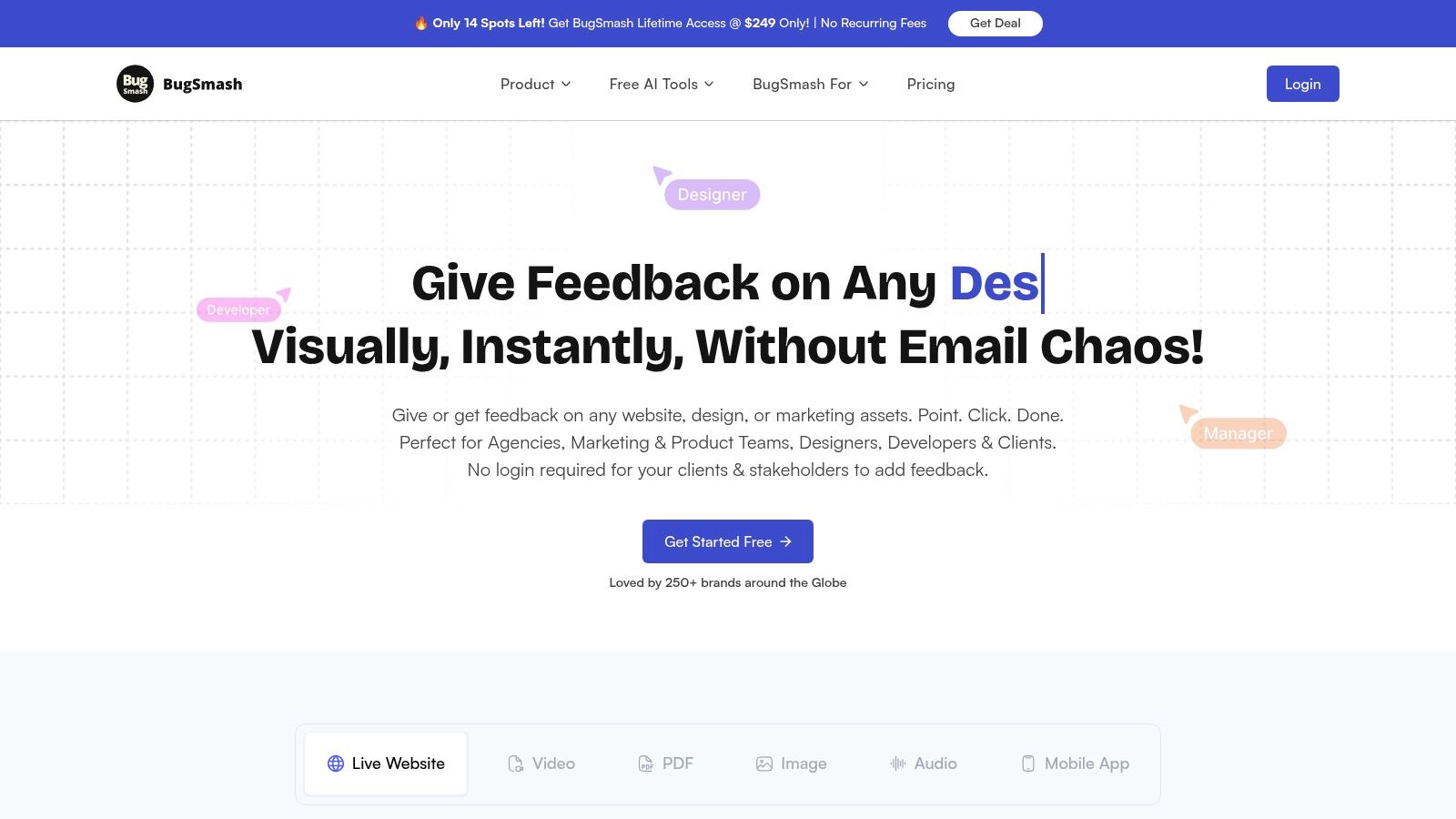
Key Features & Analysis
- Multi-Media Annotation: While many tools focus solely on websites, BugSmash supports live sites, videos, PDFs, images, and audio. This versatility is a significant advantage for teams managing comprehensive marketing campaigns or complex product launches that involve diverse media types.
- Frictionless Guest Collaboration: One of its most powerful features is allowing external stakeholders and clients to provide feedback without needing to create an account. Simply sharing a link is enough for them to start commenting, drastically reducing barriers to participation and speeding up review cycles.
- Robust Workflow Integrations: BugSmash integrates seamlessly with essential project management tools like Jira, Slack, Trello, and Asana. This allows teams to convert feedback directly into actionable tasks within their existing workflows, ensuring nothing gets lost in translation.
- Enterprise-Grade Security: With SOC 2 compliant encrypted storage, BugSmash provides peace of mind for organizations that handle sensitive client data or proprietary information, making it a secure choice for enterprise use.
Pricing & Access
BugSmash offers a highly accessible entry point with a free plan that includes unlimited usage. For those needing more advanced capabilities, paid plans are available to increase storage and file upload limits. Notably, they are currently running a special lifetime access deal for a one-time payment of $249, which presents exceptional value for teams looking to avoid recurring subscription fees.
Our Take: BugSmash is a standout solution due to its impressive versatility and user-centric design. The ability to handle diverse media formats in one place, combined with no-login guest feedback, makes it an incredibly efficient and powerful website feedback tool for almost any professional team.
| Pros | Cons |
|---|---|
| Supports websites, videos, PDFs, images, and audio | Advanced features and storage require paid plans |
| No-login feedback for clients and stakeholders | Integration library is still growing |
| Real-time threaded comments and version control | |
| Integrates with Jira, Slack, Trello, and Asana | |
| Excellent value with a free plan and lifetime deal |
2. Hotjar
Hotjar is less a single website feedback tool and more a complete digital experience insights platform. It empowers product and marketing teams to move beyond just asking for feedback and actually see how users interact with their site. Its core strength lies in combining visual behavior analysis with direct user feedback, providing a holistic view of the user experience.
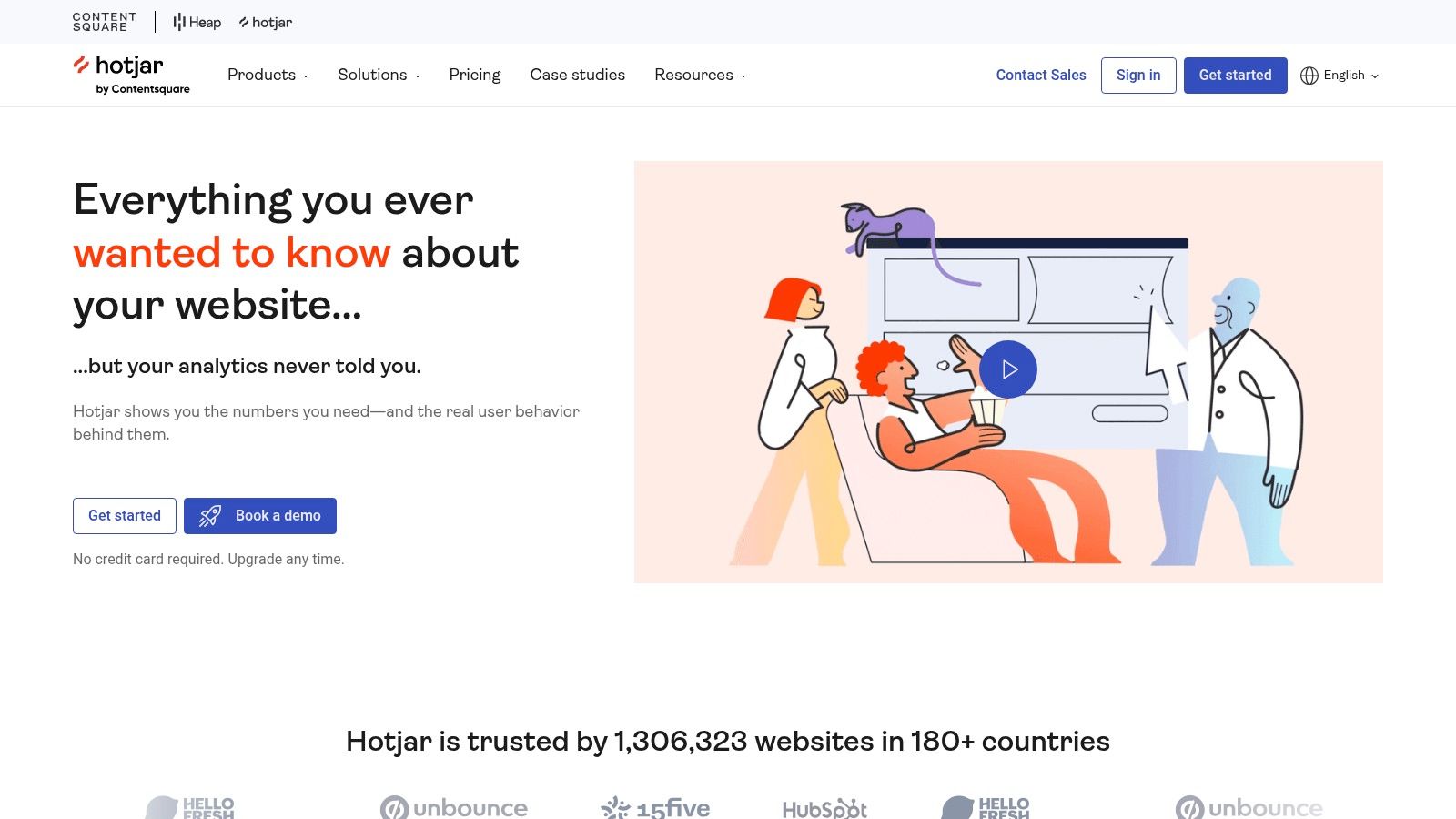
While many tools focus only on surveys or bug reports, Hotjar lets you watch a session recording of a frustrated user, see exactly where their mouse thrashed on a heatmap, and then trigger a feedback poll on that same page to ask them what went wrong. This combination is invaluable for understanding the "why" behind user actions.
Core Features & Use Cases
- Heatmaps: Visualize clicks, moves, and scrolls to identify which elements draw attention and which are ignored. Perfect for optimizing CTAs and landing page layouts.
- Session Recordings: Watch anonymous recordings of real user journeys. This is the best way to spot usability issues, bugs, and friction points that users don't explicitly report.
- Surveys & Feedback: Deploy targeted on-page surveys and feedback widgets to collect contextual opinions right when it matters most.
Pricing & Limitations
Hotjar offers a generous free plan (Observe Basic) that includes up to 35 daily sessions, which is fantastic for startups and small projects. Paid plans scale with session volume, starting at $32/month. A potential downside is that on high-traffic websites, the script can sometimes cause a minor impact on site speed, so it's wise to monitor performance after implementation.
Best for: Teams who need to connect qualitative feedback with quantitative behavioral data.
Website: https://www.hotjar.com/
3. UserTesting
UserTesting takes the concept of a website feedback tool to a more human level by connecting you with real people from your target audience to test your site. Instead of just collecting passive data or written comments, this platform provides moderated or unmoderated usability tests, delivering live video recordings of users interacting with your product and speaking their thoughts aloud. It is purpose-built for companies seeking high-quality, actionable feedback directly from their ideal customer profiles.
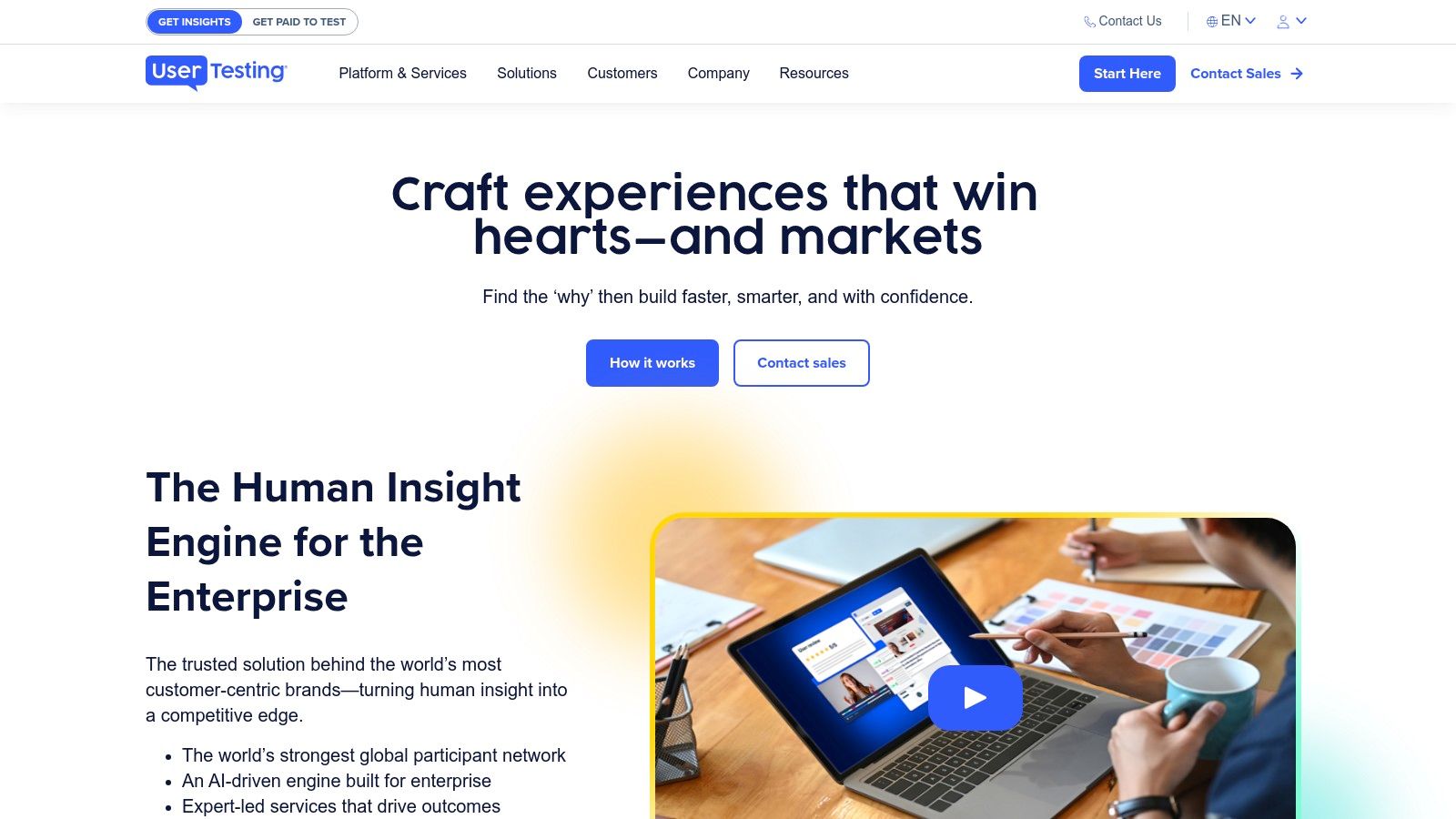
The platform's key differentiator is its powerful demographic targeting and the speed at which you can receive rich, qualitative insights. While other tools help you understand what is happening, UserTesting excels at explaining the why by letting you hear it directly from the user's mouth. This direct line to user perception is incredibly valuable for validating concepts, testing prototypes, and uncovering deep usability flaws before they impact a wider audience.
Core Features & Use Cases
- Live Video Recordings: Watch and listen to users navigate your site or app in real time, providing unfiltered reactions and commentary on the user experience.
- Targeted Demographics: Recruit test participants from UserTesting's global panel based on specific criteria like age, income, location, and professional background.
- Comprehensive Analytics: Generate highlight reels, transcripts, and sentiment analysis to easily share key findings with stakeholders and drive product decisions.
Pricing & Limitations
UserTesting's pricing is customized and quote-based, reflecting its position as an enterprise-grade solution; it is significantly more expensive than self-service tools. This higher cost is a primary limitation for smaller teams or startups. Furthermore, crafting effective test scripts and analyzing the qualitative feedback requires a dedicated time investment to ensure the insights you receive are truly valuable.
Best for: Product teams and UX researchers who need deep qualitative insights from specific user demographics.
Website: https://www.usertesting.com/
4. SurveyMonkey
SurveyMonkey is one of the most recognized names in the online survey space, making it a go-to website feedback tool for structured data collection. While not exclusively for websites, its platform is expertly designed for creating, distributing, and analyzing surveys to gather specific insights from your user base, from general satisfaction to targeted feature requests. It excels at formal, long-form feedback collection where detailed, multi-question input is necessary.
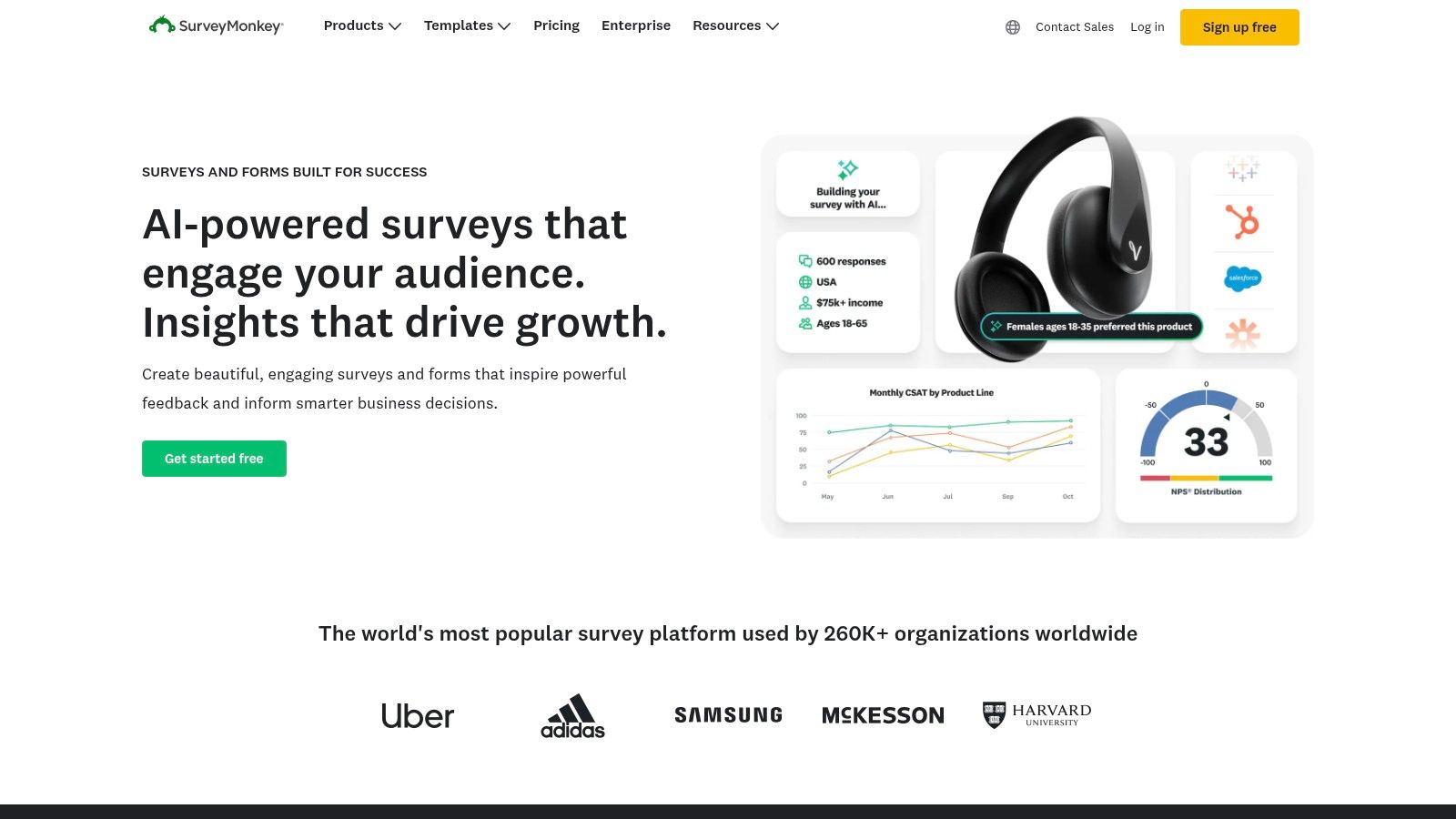
Unlike visual feedback tools that focus on in-the-moment UI reactions, SurveyMonkey’s strength is in its robust survey logic and powerful analytics. You can send post-purchase satisfaction surveys via email, poll users about new feature ideas, or conduct in-depth market research. This makes it ideal for product managers and marketing teams who need quantifiable data to drive strategic decisions and present findings to stakeholders.
Core Features & Use Cases
- Extensive Template Library: Start quickly with professionally designed templates for customer satisfaction (CSAT), Net Promoter Score (NPS), and website usability feedback.
- Advanced Question Logic: Create dynamic surveys that show or hide questions based on previous answers, ensuring a relevant experience for every respondent.
- Powerful Analytics & Reporting: Automatically generate charts, graphs, and reports to analyze responses, identify trends, and easily share insights with your team.
Pricing & Limitations
SurveyMonkey offers a basic free plan, but it's quite limited, restricting you to 10 questions and 25 viewable responses per survey. To unlock its true power, you'll need a paid plan, which starts at $39/month. The main drawback is that it’s not an "on-page" tool; you typically have to direct users to the survey via a link, which can add friction compared to embedded widgets.
Best for: Teams needing structured, quantifiable data from detailed user surveys.
Website: https://www.surveymonkey.com/
5. Qualaroo
Qualaroo specializes in asking the right questions at the right moment. This website feedback tool excels at deploying targeted, contextual surveys known as "Nudges" directly on your website or app. Instead of waiting for users to find a feedback button, Qualaroo proactively engages them based on their behavior, location, or time on site, capturing insights while they are fresh.
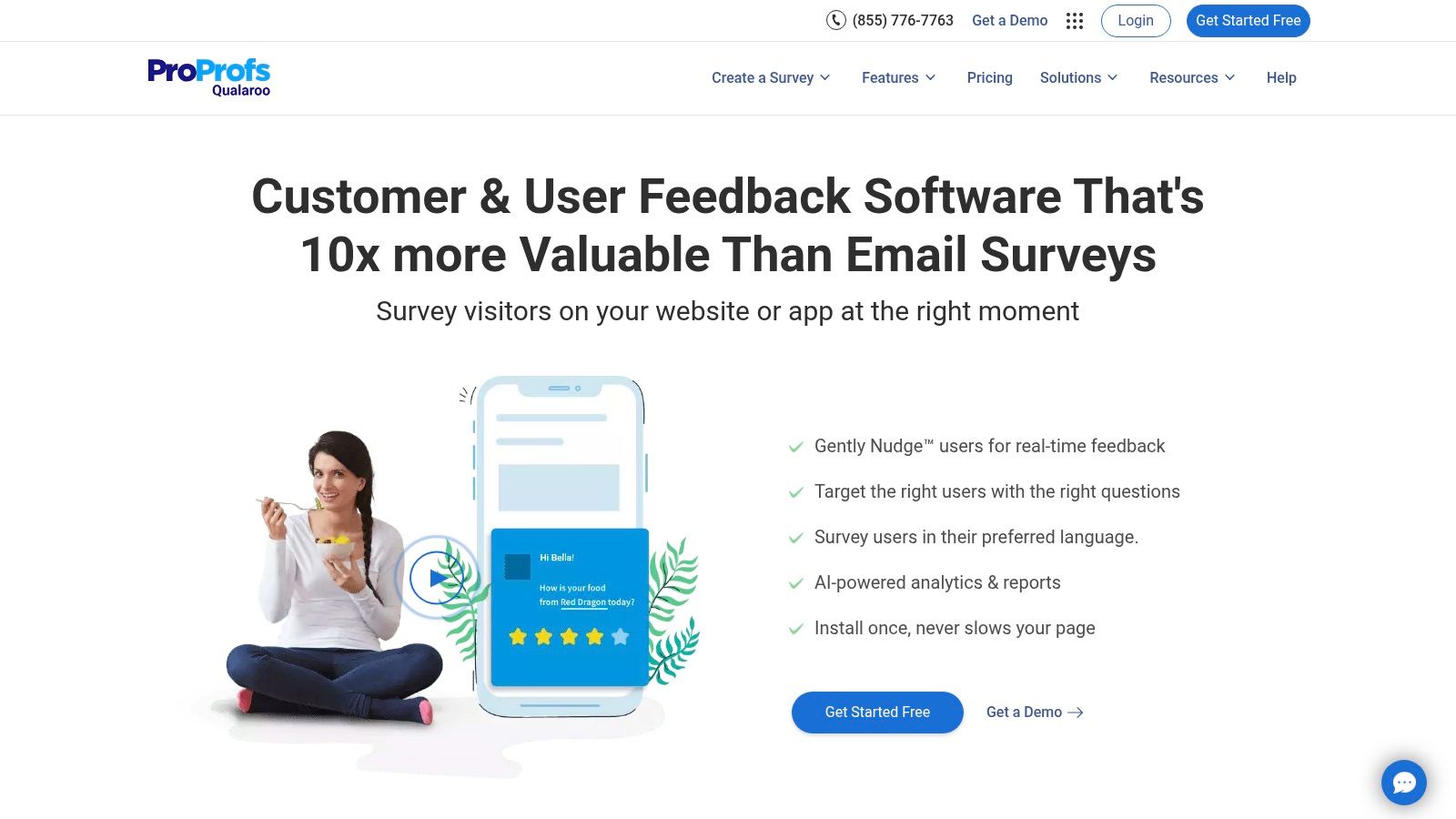
The platform’s key differentiator is its intelligent survey targeting and AI-powered analytics. It allows you to move beyond generic feedback forms and get answers to specific questions, like why users are abandoning a cart or what information is missing from a pricing page. This makes it a powerful tool for conversion rate optimization and understanding user intent. For those interested in a deeper analysis, you can learn more about how Qualaroo stacks up as a feedback tool for websites.
Core Features & Use Cases
- Advanced Targeting: Trigger surveys based on user behavior, such as exit intent, time on page, scroll depth, or referral source. Ideal for collecting hyper-relevant feedback.
- AI-Powered Sentiment Analysis: Automatically analyze open-ended text responses to gauge user emotion and identify key themes without manual sorting.
- Customizable Nudges: Design surveys that match your brand's look and feel, ensuring a seamless user experience.
Pricing & Limitations
Qualaroo’s plans start at $69/month (billed annually), which can be a significant investment for smaller businesses or startups. The free plan is quite limited, making it more of a trial than a long-term solution. While powerful, the sheer number of customization options can present a learning curve for new users.
Best for: Marketing and product teams focused on conversion optimization and deep user journey analysis.
Website: https://qualaroo.com/
6. Mopinion
Mopinion stands out as an enterprise-grade, all-in-one user feedback software designed for organizations that need to collect and analyze feedback across multiple digital channels. It allows teams to gather insights not just from their website, but also from mobile apps and email campaigns, centralizing feedback data into a single, actionable dashboard. This multi-channel approach makes it a powerful website feedback tool for creating a cohesive customer experience strategy.
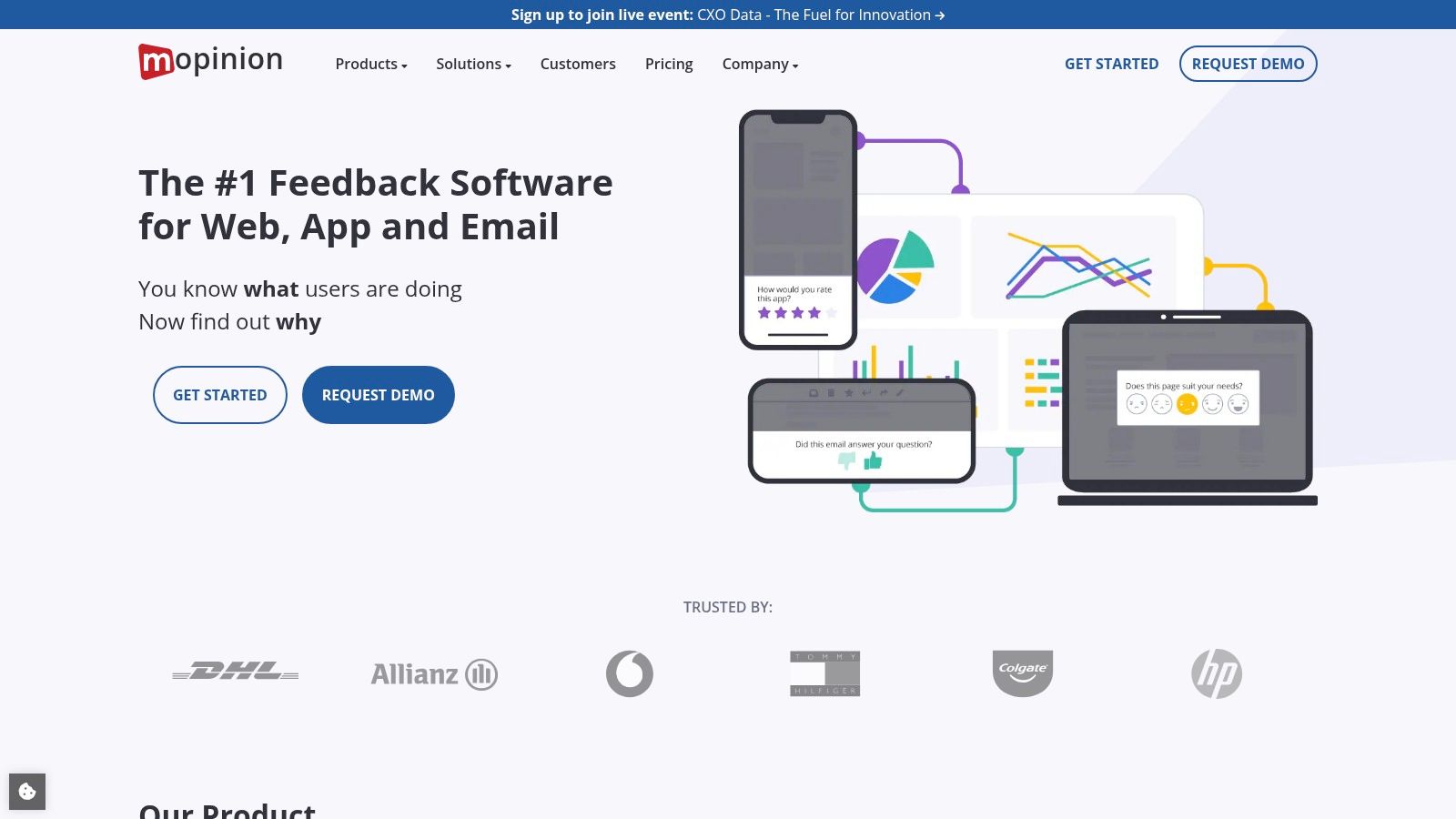
Where many tools focus on a single touchpoint, Mopinion excels at unifying feedback from every stage of the customer journey. You can deploy a survey after an online purchase, trigger a feedback form within your mobile app, and embed a feedback button in an email newsletter, then analyze all that data together to spot overarching trends and pain points.
Core Features & Use Cases
- Multi-Channel Feedback: Collect feedback via highly customizable forms on websites, in-app, and through email campaigns. Ideal for mapping the entire customer journey.
- Advanced Analytics & Reporting: Use text analytics, sentiment analysis, and customizable dashboards to turn raw feedback into strategic insights without manual effort.
- Robust Integrations: Seamlessly connect with tools like Slack, Jira, Salesforce, and a host of marketing automation platforms to incorporate feedback into existing workflows.
Pricing & Limitations
Mopinion offers a free trial, with paid plans starting at a higher price point than some competitors, reflecting its enterprise focus. The Standard plan begins at $259/month. The platform’s extensive customization options and powerful analytics may present a steeper learning curve for smaller teams or new users who don't need its full suite of features.
Best for: Large businesses and enterprises needing a comprehensive, multi-channel feedback and analytics solution.
Website: https://mopinion.com/
7. UserVoice
UserVoice goes beyond simple feedback collection, positioning itself as a comprehensive product feedback management system. It's built for product teams that need a structured way to gather, aggregate, and act on user suggestions at scale. Its main differentiator is its focus on creating a feedback loop where users can not only submit ideas but also vote on existing ones, giving product managers clear, data-driven signals on what to build next.
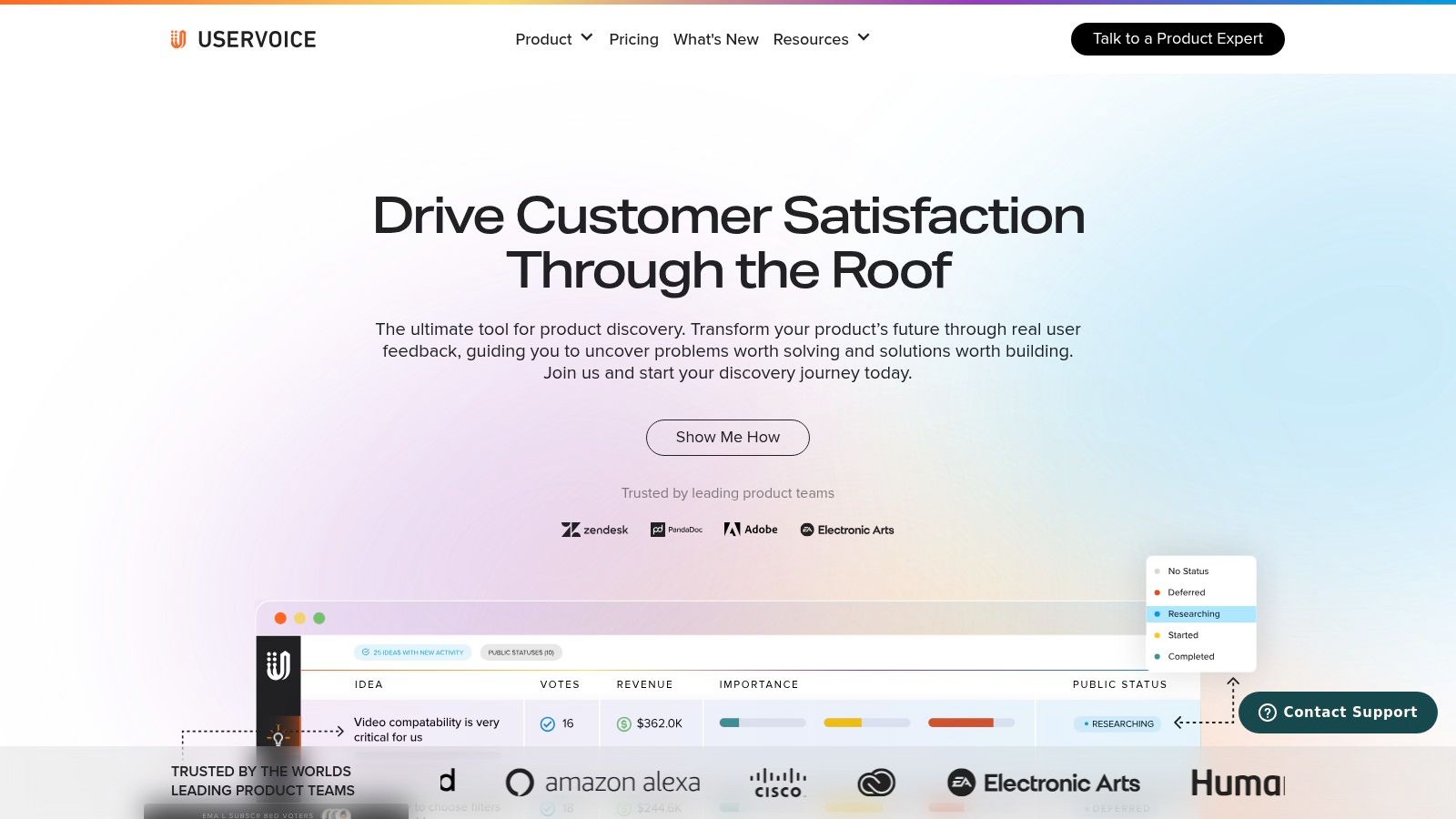
This platform excels at turning a chaotic stream of requests into a prioritized roadmap. Instead of just knowing a user is unhappy, you learn exactly what feature they believe will solve their problem. This makes it an invaluable website feedback tool for customer-driven development and long-term product strategy.
Core Features & Use Cases
- Customizable Feedback Forums: Create a dedicated space where users can submit new ideas, browse existing ones, and comment on suggestions.
- Feature Request Voting & Prioritization: Users vote on the ideas they find most valuable, providing a clear, democratic ranking of feature requests for your product team.
- CRM & Development Tool Integrations: Connect feedback directly to your development workflow by integrating with tools like Jira, Azure DevOps, and Salesforce.
Pricing & Limitations
UserVoice is a premium tool targeted at established companies, with pricing starting at $699/month. This higher cost makes it less accessible for small businesses or startups. While powerful, some users have noted that its interface can feel less modern or intuitive compared to newer competitors.
Best for: SaaS companies and enterprise-level product teams focused on building a customer-driven roadmap.
Website: https://www.uservoice.com/
8. Survicate
Survicate is a highly versatile and user-friendly survey platform designed to capture customer insights across multiple touchpoints. While many tools focus on a single feedback channel, Survicate excels at letting you deploy targeted surveys directly on your website, via email, or even inside your mobile or web application. This multi-channel approach ensures you can gather feedback at the most relevant moments in the customer journey.
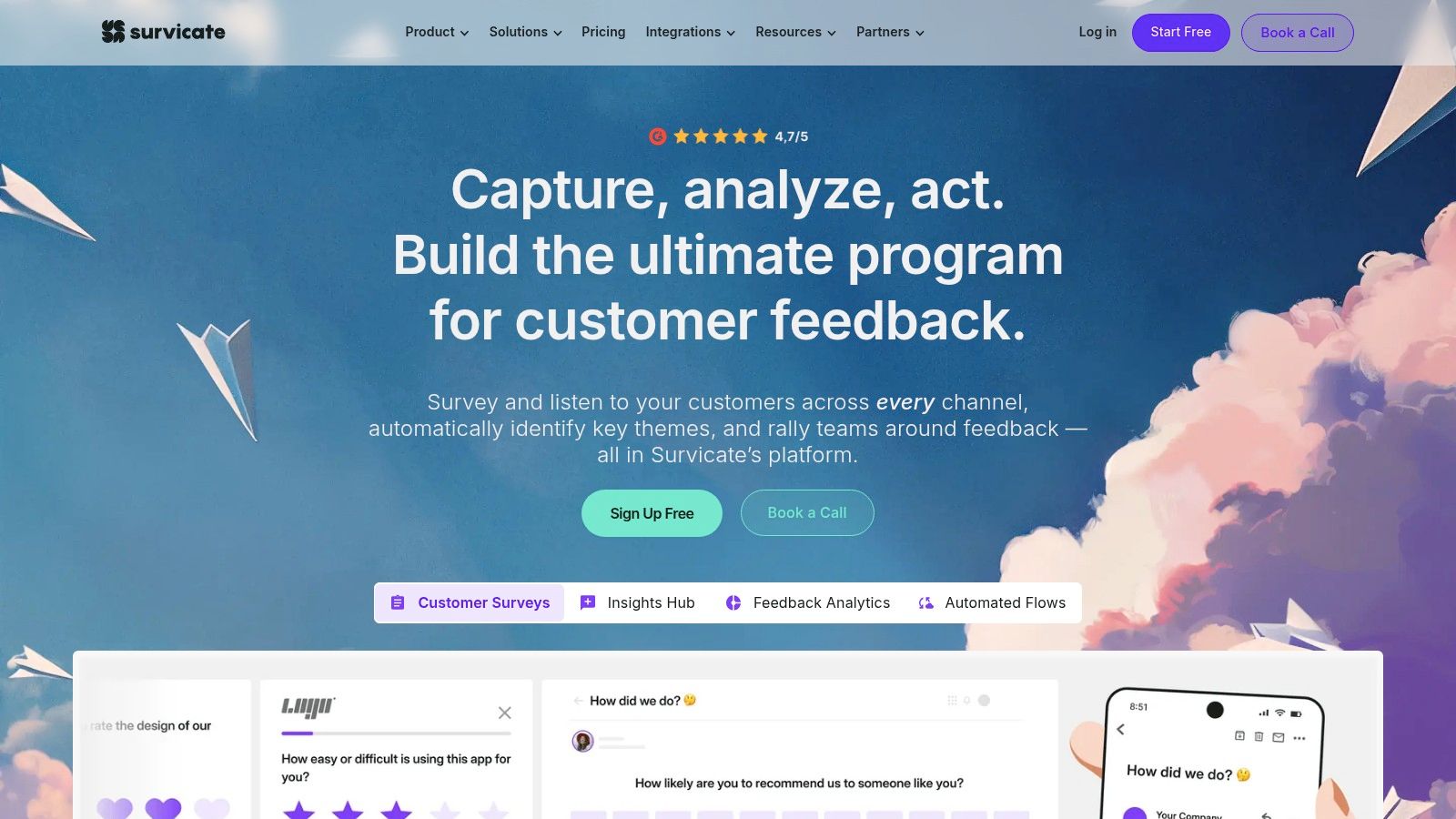
The platform's key differentiator is its powerful targeting and extensive integration capabilities. You can trigger a survey based on user behavior, such as time on page or exit intent, or based on user attributes synced from your CRM. This makes it a fantastic website feedback tool for getting specific, actionable data from the right user segments without disrupting their experience.
Core Features & Use Cases
- Multi-Channel Surveys: Collect feedback through website widgets, email-embedded surveys, and in-product prompts to meet users where they are.
- Advanced Targeting: Trigger surveys based on custom attributes, events, or user behavior. Ideal for post-purchase feedback or gauging feature satisfaction.
- Broad Integrations: Connects seamlessly with popular tools like HubSpot, Intercom, and Slack, allowing you to sync feedback data directly into your existing workflows.
Pricing & Limitations
Survicate offers a free plan with up to 25 monthly responses, perfect for testing the waters. Paid plans start at $99/month, scaling with response volume and feature access. The main limitation is that the free plan is quite restrictive, and more advanced features like custom branding and sophisticated targeting logic are reserved for higher-tier plans.
Best for: Teams needing a flexible, multi-channel survey tool that integrates deeply with their marketing and sales stack.
Website: https://survicate.com/
9. GetFeedback
GetFeedback is a sophisticated website feedback tool designed to help businesses create engaging, mobile-first surveys. Its primary focus is on collecting high-quality customer feedback to measure and improve customer experience (CX) metrics like CSAT and NPS. The platform excels at making the feedback process feel like a natural part of the customer journey, rather than an intrusive interruption.
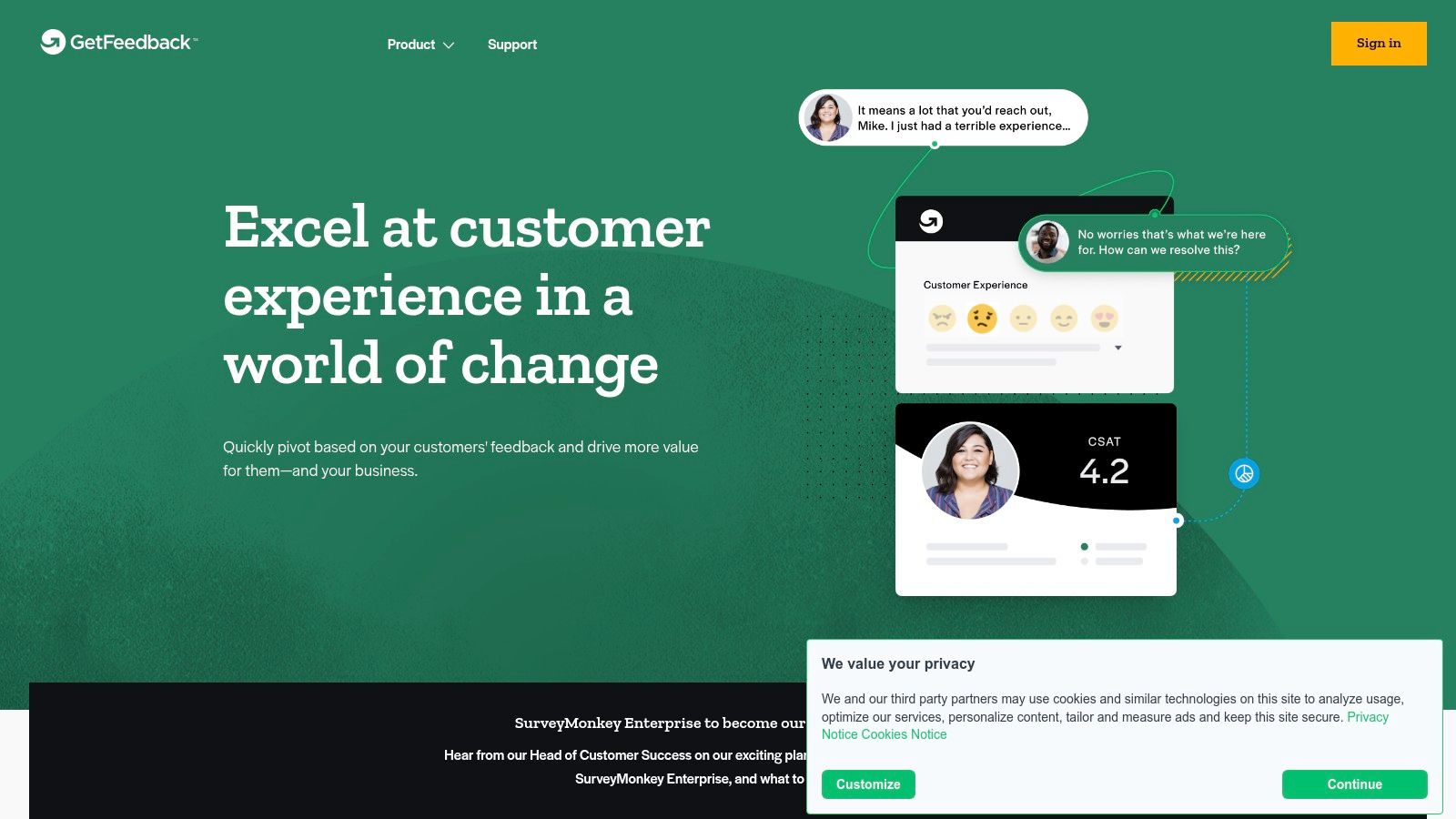
Where many tools offer generic survey templates, GetFeedback shines with its powerful customization and seamless integration capabilities, particularly with Salesforce. This allows teams to trigger surveys based on specific customer interactions logged in their CRM, such as after a support ticket is closed or a purchase is made, ensuring feedback is timely and highly relevant.
Core Features & Use Cases
- Mobile-First Surveys: Design beautiful, responsive surveys that look great on any device, increasing completion rates.
- Salesforce Integration: Its deep integration allows for automated feedback collection tied directly to customer records, providing a 360-degree view of the customer.
- Real-time Dashboards: Analyze incoming feedback instantly with customizable dashboards and reports to track key CX metrics and spot trends as they emerge.
Pricing & Limitations
GetFeedback’s pricing is quote-based and tailored to specific business needs, generally positioning it for mid-market to enterprise companies. The cost may be a significant barrier for small businesses or startups. While powerful, some of the deeper customization options and analytics features are reserved for higher-tier plans. For those interested in a wider view of available tools, you can explore other feedback management software options.
Best for: Salesforce-centric businesses focused on measuring and improving customer satisfaction metrics.
Website: https://www.getfeedback.com/
10. Zonka Feedback
Zonka Feedback distinguishes itself as an omnichannel customer experience platform that extends far beyond a simple website feedback tool. It is designed for businesses that need to capture feedback not just online, but across every conceivable touchpoint, including email, SMS, QR codes, and even offline kiosks. This makes it ideal for companies with both a digital and physical presence.
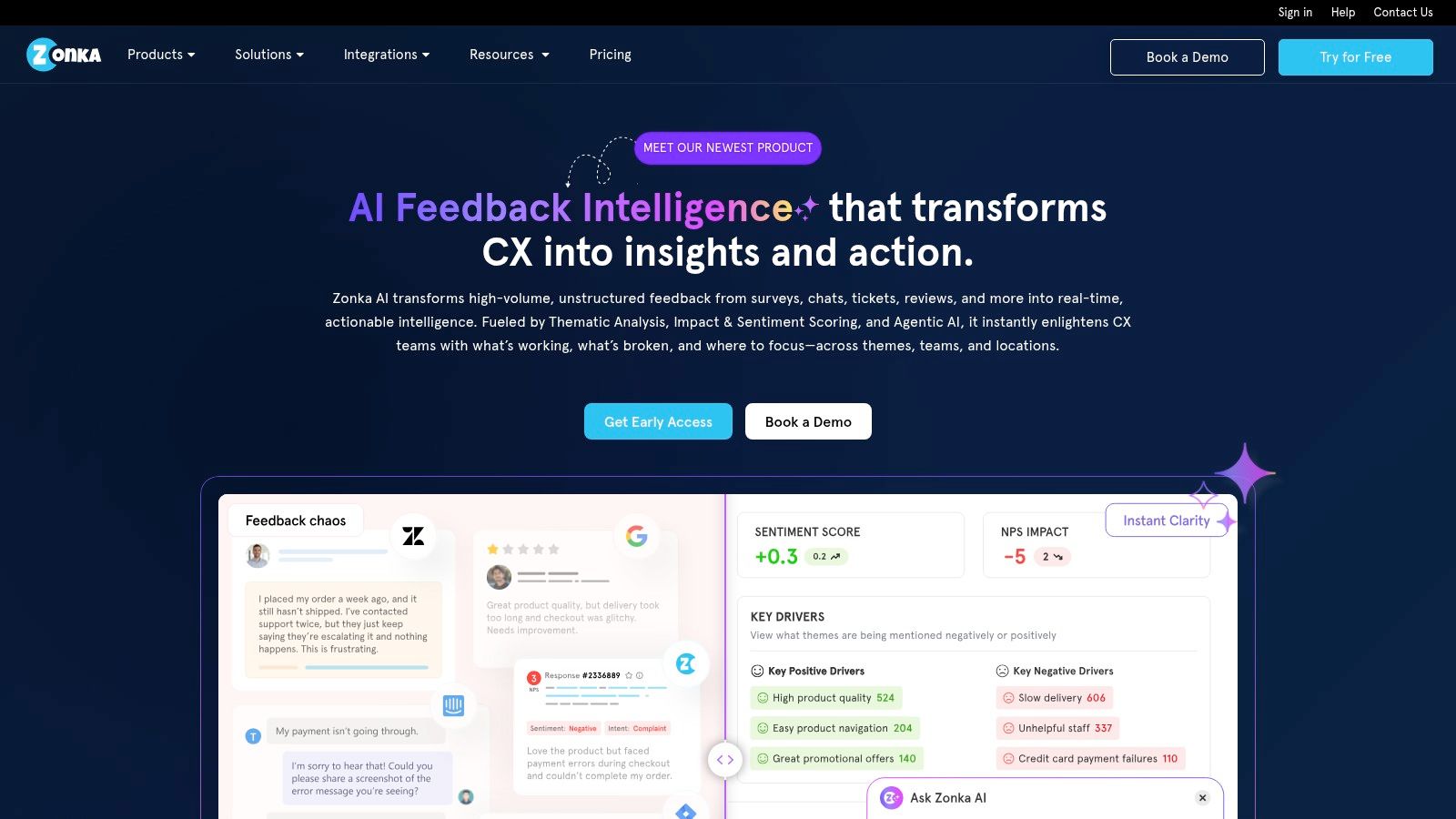
While many competitors focus purely on the website, Zonka Feedback helps you consolidate insights from your app, your store, and your support interactions into one unified dashboard. This holistic view allows teams to track the entire customer journey and identify friction points that might originate outside the website but still impact online behavior and satisfaction.
Core Features & Use Cases
- Multichannel Feedback Collection: Deploy surveys via link, email, SMS, or on-site widgets. Perfect for capturing post-purchase feedback or gauging satisfaction after a support ticket is closed.
- Customizable Surveys & Forms: Build anything from simple Net Promoter Score (NPS) surveys to complex, multi-page questionnaires with conditional logic.
- Advanced Reporting & Analytics: Dive deep into the data with real-time reports, text analysis, and sentiment tracking to quickly identify trends and urgent issues.
Pricing & Limitations
Zonka Feedback offers a limited free plan suitable for testing the platform. Paid plans start at $49/month and scale up based on features and response volume. The primary limitation is that many of the most powerful features, like advanced reporting and integrations, are reserved for higher-tier plans, which may be a hurdle for smaller businesses.
Best for: Businesses needing to unify feedback from both online and offline customer touchpoints.
Website: https://www.zonkafeedback.com/
11. Userback
Userback excels at removing the friction from collecting visual feedback, making it an indispensable website feedback tool for agencies, developers, and product teams. It allows end-users and testers to report bugs and suggest improvements with annotated screenshots and screen recordings directly from the live website or web application. This eliminates the confusing back-and-forth of "can you send me a screenshot?" and streamlines the entire QA and feedback process.
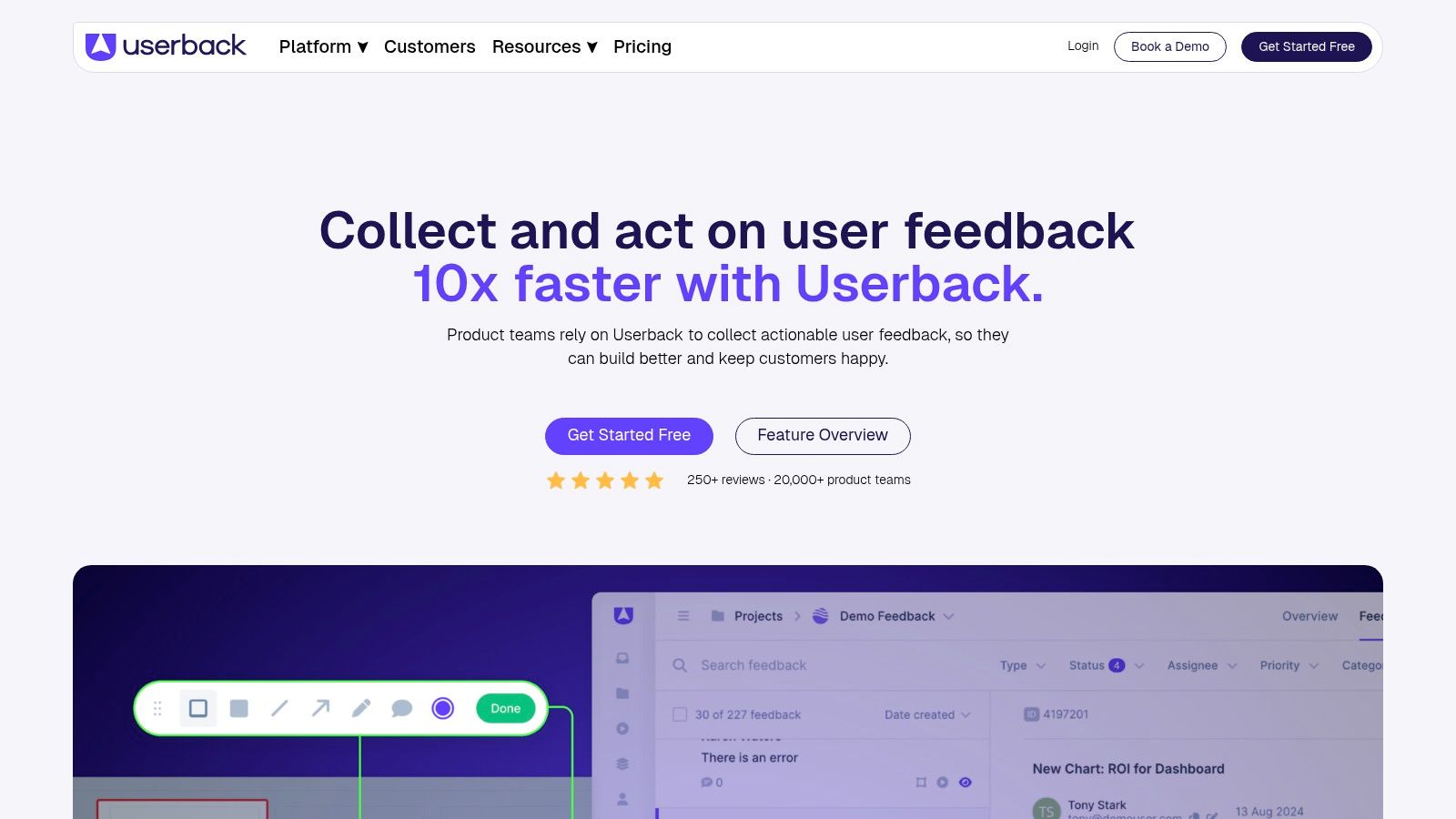
What makes Userback stand out is its deep integration into the development workflow. Instead of feedback living in a separate inbox, it can be pushed directly into project management tools like Jira, Asana, or Slack. This ensures that visual, context-rich bug reports land right where developers are already working, complete with browser information and console logs.
Core Features & Use Cases
- Annotated Screenshots & Video: Users can draw, comment, and even record their screens to show exactly what's wrong, providing crystal-clear context for every report.
- Workflow Integration: Send feedback directly to popular project management tools to turn reports into actionable tasks without manual data entry.
- Customizable Feedback Widget: Tailor the look and feel of the feedback button and form to match your brand, ensuring a seamless user experience.
Pricing & Limitations
Userback offers a 14-day free trial across its plans. Paid plans start at $59/month for the "Startup" plan, which is geared towards small teams. A potential limitation is that while excellent for visual bug reporting and client feedback, it's less focused on broad quantitative analysis like heatmaps or large-scale user surveys found in other platforms.
Best for: Agencies and dev teams needing a streamlined way to collect visual bug reports and client feedback.
Website: https://www.userback.io/
12. Trustpilot
Trustpilot shifts the focus of a website feedback tool from on-page usability to off-site brand reputation and social proof. It's a consumer review platform where businesses invite customers to leave public feedback, creating a transparent record that builds trust with prospective buyers. Its power lies in using genuine customer sentiment as a marketing and trust-building asset.
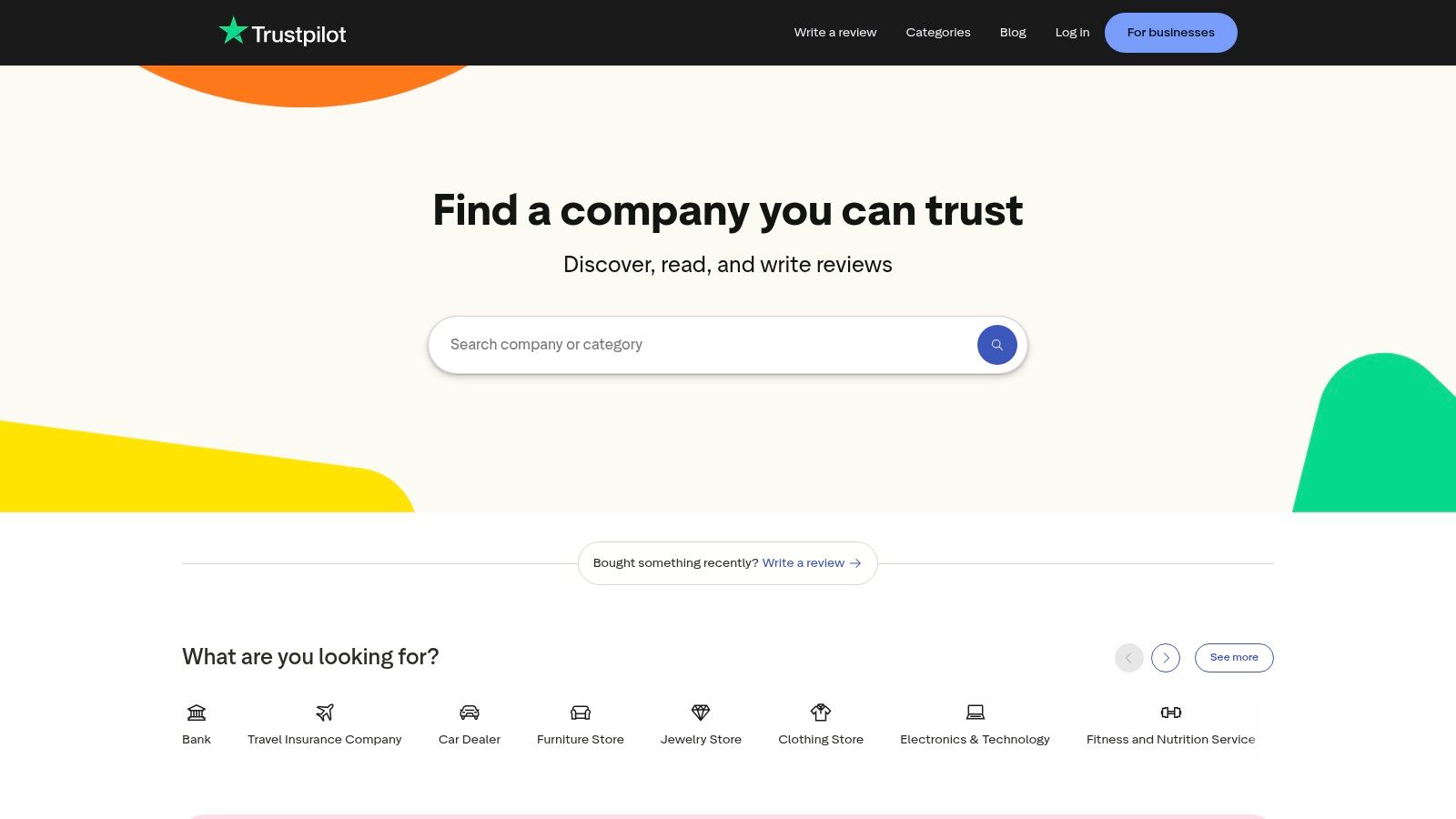
Unlike tools that capture private feedback for internal improvement, Trustpilot makes that feedback public. This system encourages businesses to prioritize excellent customer service and product quality, as reviews directly impact their online reputation. It turns the voice of the customer into a powerful, verifiable testimonial that influences purchasing decisions before a user even visits your site.
Core Features & Use Cases
- Customer Review Collection: Send automated or manual review invitations to customers post-purchase to systematically gather feedback.
- Review Management and Response: Engage directly with reviewers by responding to both positive and negative feedback, showing active customer care.
- TrustBox Widgets: Embed dynamic review scores and testimonials directly onto your website to leverage social proof and boost conversion rates.
Pricing & Limitations
Trustpilot offers a free plan to start collecting and managing reviews. Paid plans, starting at $250/month, unlock advanced features like analytics, invitation automation, and more widget options. A key consideration is that this is a public forum; negative reviews are visible and require a proactive management strategy. The platform is also more focused on company-level feedback than specific on-page UX issues.
Best for: E-commerce and service-based businesses focused on building public trust and leveraging social proof.
Website: https://www.trustpilot.com/
Website Feedback Tools Feature Comparison
| Platform | Core Features & Media Support | User Experience & Quality ★ | Value & Pricing 💰 | Target Audience 👥 | Unique Selling Points ✨ |
|---|---|---|---|---|---|
| 🏆 BugSmash | Multi-format annotation (websites, PDFs, videos) | ★★★★★ Intuitive, real-time | Free unlimited; Lifetime $249 one-time | Product, marketing, dev teams, agencies | No-login feedback; SOC 2 security; Jira/Slack integration |
| Hotjar | Heatmaps, session recordings, surveys | ★★★★ User-friendly | Free basic; paid plans | Website owners, marketers | Visual user behavior insights |
| UserTesting | Live user video sessions, targeted demographics | ★★★★★ High-quality actionable | Higher cost | Product teams, UX researchers | Real-time user behavior feedback |
| SurveyMonkey | Survey templates, analytics, 3rd-party integrations | ★★★★ Scalable & robust | Free limited; advanced tiers | Businesses of all sizes | Extensive survey library |
| Qualaroo | Targeted on-site surveys, AI sentiment analysis | ★★★★ Customizable surveys | Higher cost, limited free | Marketing teams, website owners | AI-powered analytics; real-time feedback |
| Mopinion | Multi-channel feedback (web, apps, email) | ★★★★ Real-time data & analytics | Higher pricing | Enterprises needing multi-channel feedback | Comprehensive multi-channel support |
| UserVoice | Feedback forums, voting & prioritization | ★★★★ Centralized management | Higher cost | Product teams, customer-driven development | Feature request prioritization |
| Survicate | Website/email/in-product surveys | ★★★★ Easy, flexible | Free limited; paid for advanced | Marketers, customer success teams | Multi-channel survey distribution |
| GetFeedback | Mobile-friendly surveys, Salesforce integration | ★★★★ User-friendly | Higher pricing | Salesforce users, customer experience teams | Mobile focus; strong integrations |
| Zonka Feedback | Multi-channel surveys, advanced reporting | ★★★★ Comprehensive feedback | Free limited; paid tiers | Customer experience teams | Multichannel feedback collection |
| Userback | Annotated screenshots, screen recordings | ★★★★ Simplifies feedback | Free limited | Web teams, small to mid-sized businesses | Visual bug reporting; PM tool integrations |
| Trustpilot | Customer reviews, reputation management | ★★★★ Builds trust & analytics | Costly for SMBs | eCommerce, online businesses | Review management & credibility building |
Final Thoughts
Navigating the landscape of website feedback tools can feel overwhelming, but making an informed choice is a pivotal step toward building a truly user-centric digital experience. We've explored a diverse array of platforms, from the visual bug reporting prowess of BugSmash and Userback to the comprehensive behavioral analytics of Hotjar. We’ve seen how giants like UserTesting provide deep qualitative insights, while survey specialists like SurveyMonkey, Qualaroo, and Survicate excel at capturing structured user sentiment at scale.
The core takeaway is this: there is no single "best" website feedback tool for everyone. The ideal solution is deeply contextual, hinging entirely on your specific goals, team structure, and budget. Your decision-making process should be a strategic exercise, not just a feature comparison.
How to Choose the Right Website Feedback Tool
To cut through the noise and select the platform that will deliver the most value, start by answering these critical questions:
- What is my primary goal? Are you trying to squash bugs faster, understand user journey friction points, validate a new feature idea, or measure overall customer satisfaction? A tool like BugSmash is built for pinpointing technical issues, while UserVoice is designed for collecting and prioritizing feature requests. Aligning the tool with your objective is the most crucial step.
- Who will be using the tool? Consider the technical aptitude of your team. Developers and QAs need a tool with robust technical logs and console data. In contrast, product managers and marketers might prioritize visual feedback, heatmaps, and easy-to-digest survey dashboards.
- How will this integrate into my existing workflow? The most powerful tool is useless if it creates friction. Look for integrations with your project management software (like Jira or Trello), communication platforms (like Slack), and other essential systems. Streamlining this process ensures that feedback doesn't just get collected; it gets acted upon. Beyond specific feedback solutions, integrating these insights can also complement your overall suite of tools designed to enhance team productivity and workflow. Exploring the best team productivity apps can help you create a more cohesive and efficient operational ecosystem.
Implementing for Success
Once you've made your choice, remember that implementation is just as important as selection. Don't simply switch on the tool and hope for the best. Be intentional. Introduce it to your team with clear guidelines on how and when to use it. Educate your users on how their feedback will be used to create a transparent loop that encourages future participation.
Ultimately, a website feedback tool is more than just software; it's a bridge connecting you directly to the people who matter most: your users. By actively listening, analyzing, and acting on their insights, you transform your website from a one-way broadcast into a dynamic, collaborative conversation. This commitment to continuous improvement is the true engine of digital growth.
Ready to eliminate the guesswork from bug reporting and user feedback? BugSmash provides a simple yet powerful solution for collecting visual, actionable feedback with all the technical data your developers need. Stop deciphering vague emails and start fixing issues faster with our intuitive BugSmash website feedback tool.



